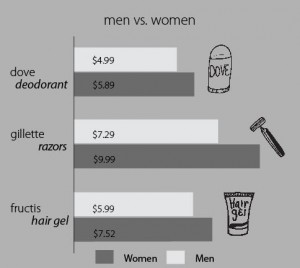
Gendered marketing goes beyond the make-believe kitchens and toy guns of childhood, following individuals far into adulthood. Mimicking the clearly defined toy aisles—one just for girls, and one just for boys—cosmetic and clothing aisles noticeably don’t just use signs to boast the difference between two genders.
An easy distinction to spot lies in packaging. Women’s care products come in smooth containers with bright decals and soft colors, while products made for men are packaged with bolder fonts and darker colors.
While this doesn’t seem harmful (it’s the way things have always been, right?), it’s not inclusive of those who aren’t a part of the established gender binary. Beyond this problem, skewed prices and differences in quality of the same products show that this marketing technique favors those who buy the male products, making gendered marketing a misogynistic problem as well.
